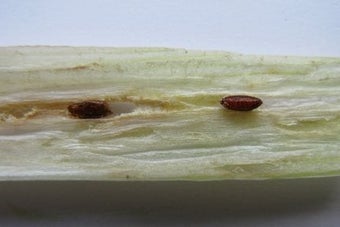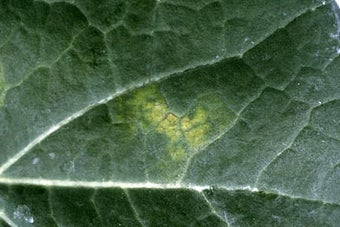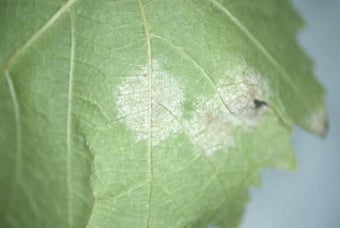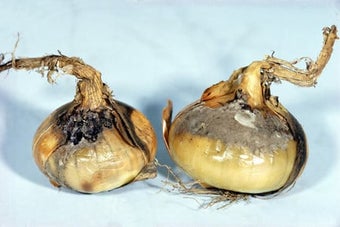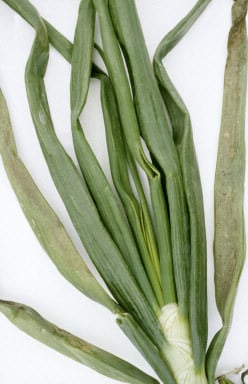
Quick facts
Common name - Onion downy mildew
Scientific name - Peronospora destructor
Plants affected - Onions, including salad onions, shallots, some perennial onions including chives
Main symptoms - Leaf yellowing and dieback, with white and then purple fungal growth
Cause - Fungus-like (Oomycete) organism
Timing - Late spring and summer
What is onion downy mildew?
Onion downy mildew is caused by the fungus-like (Oomycete) organism Peronospora destructor, which infects first the leaves and later of onions and shallots in mild, humid weather in late spring and summer. Some onions such as chives may also be infected.
It is worse in cool wet seasons and in wet areas. Closely spaced crops such as salad or spring onions are especially vulnerable.
Symptoms
Be alert for the following symptoms:
- The affected leaves turn yellow and die off from the tip downwards
- In moist conditions a white, and later purplish mould develops on affected parts of the leaf
- This, in turn, is commonly followed by darker mould growth of other leaf-colonising fungi
- can also be infected and often sprout prematurely or shrivel in store
Control
Non-chemical control
- Avoid overcrowded crops, damp conditions and sheltered sites, and maintain good weed control to ensure airflow through the crop
- Do not infected material
- It is recommended to remove and dispose of affected plants and avoid replanting with onions or shallots for five years
- It is important not to allow any to remain in the soil from year to year. The fungus remains in infected bulbs, producing spores in the spring which spread the disease to newly sown plants
- Any soft, mouldy or otherwise suspect onion sets should not be planted
- Onions sown in late summer for over-wintering can carry the disease from year to year
- Onion sets for over-wintering, planted in late September, should be less vulnerable to infection and acting as a source of the disease for crops sown or planted the following year
- However, if possible separate over-wintered crops as much as possible from spring ones
- Similarly, onions should be separated from other onion crops in the vegetable garden
Resistance: Cultivars showing some resistance to onion downy mildew are now offered by seed companies supplying home gardeners, including the F1 hybrids ‘Hylander’ and ‘Santero’. These appear to offer good protection.
Chemical control
There are no fungicides available to gardeners for the control of onion downy mildew.
Biology
The downy mildews are a large group of plant diseases caused by microscopic, fungus-like organisms related to the pathogen that causes tomato and potato blight. Despite a similar name and certain similarities in symptoms, they are unrelated to the powdery mildews.
The disease is spread throughout the summer by spores produced on the infected leaves. These spores are splashed by rain, and are also carried for long distances on the wind. Extended periods of leaf wetness are required for spore production and infection, so severe outbreaks of downy mildew are only likely to occur during wet summers.
The airborne spores remain viable for just a short time, but the fungus can also produce a second spore type (a resting spore) within the affected plant tissues. These resting spores are much more resilient, and are released into the soil as the diseased material rots down. They are likely to survive within the soil for a long time.
The fungus can remain within affected , producing spores in spring that spread the disease to newly-sown plants.
